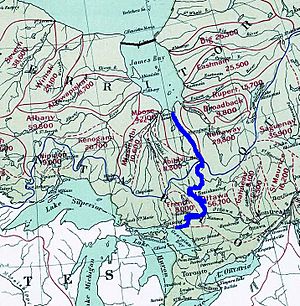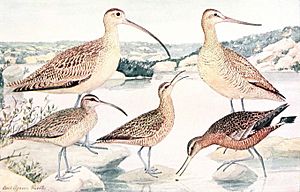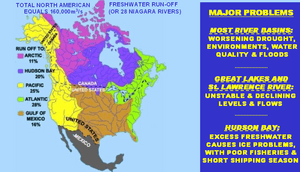Great Recycling and Northern Development Canal facts for kids

The Great Recycling and Northern Development (GRAND) Canal of North America or GCNA is a big idea for managing water. It was proposed by an engineer named Thomas Kierans from Newfoundland and Labrador. His goal was to help solve problems with not enough freshwater in North America. The plan suggested building a huge dam in James Bay. This dam would stop the freshwater from mixing with the salty water of Hudson Bay. This would create a giant freshwater lake. Some of this water would then be pumped south into Georgian Bay, which would raise the water levels in the lower Great Lakes. The amount of water moved would be like 2.5 Niagara Falls!
Thomas Kierans promoted this plan from 1959 until he passed away in 2013. His son, Michael Kierans, continues to support it. This idea came about because the water quality in the Great Lakes and other important areas in Canada and the United States was getting worse. Kierans believed that to avoid a water crisis from future dry periods, new sources of fresh water were needed, along with saving water.
In the 1960s and again in the 1980s, when Great Lakes water levels dropped a lot, people became interested in the GRAND Canal. However, the governments of the US and Canada have been hesitant to agree on such a large international water-sharing project. Also, there are worries about how the plan might harm the environment. These concerns have stopped the idea from being seriously considered.
Contents
Why Was the GRAND Canal Proposed?
In 1959, Canada officially complained that the U.S. was taking too much water from Lake Michigan through a channel called the Chicago Sanitary and Ship Canal. Canada said this would hurt areas in the Great Lakes Basin.
The Canadian government also stated that they had studied the issue and found no other sources of freshwater in Canada to replace the water taken from the Great Lakes. Thomas Kierans disagreed. He said that the GRAND Canal could provide plenty of extra fresh water to the Great Lakes.
Today, water from the Ogoki River and Longlac is already being moved into the Great Lakes. The amount is similar to what the U.S. takes at the Chicago channel.
What Is the GRAND Canal Plan?
In his plan, Kierans suggests that Canada could create a huge new freshwater source in James Bay. This would be done by building a large wall, or dyke, that would collect water from many nearby rivers. This idea is based on how the Netherlands created new land and freshwater lakes. The project would capture all the water flowing out from rivers like the La Grande, Eastmain, Rupert, and many others.
Kierans also claims that the California Aqueduct shows that water can be moved long distances and uphill. He believes the GRAND Canal could do the same for the water from James Bay. The GCNA would help keep water levels steady in the Great Lakes and the St. Lawrence River. It would also make the water cleaner. The GRAND Canal system would deliver new fresh water from the James Bay area, through the Great Lakes, to many places in Canada and the United States that need water. In 1994, it was estimated that building this project would cost about C$100 billion. Running it would cost another C$1 billion each year. It would need many nuclear reactors and hydroelectric dams to pump water uphill into other river systems.
What Are the Benefits and Costs?
Kierans believes that moving water from James Bay would not cause harm. Instead, he argues it would bring many good things to both Canada and the United States, such as:
- More fresh water for both countries. This would help keep Great Lakes and St. Lawrence water levels stable. It would also help areas in western Canada and the southwestern U.S. that are short on water or facing dry periods. It could even help refill the Ogallala Aquifer, a huge underground water source.
- Better fishing and shipping in Hudson Bay. An expert named Professor Max Dunbar said that Hudson Bay has too much fresh water, which means it's not good for commercial fishing. By moving freshwater away from Hudson Bay, the GRAND Canal would make its water saltier. This would improve fishing and also reduce how long the bay freezes over in winter, making shipping easier.
- Cleaner water in the Great Lakes because more water would be flowing through them.
- More electricity available for other uses. The cost of electricity for users could also go down by combining the energy needed for water transfer with times when electricity demand is highest.
- Better control over floods.
- Improved protection against forest fires for both nations.
- Building and running the GCNA would boost the economy. It would create many jobs and help avoid economic slowdowns. This would be similar to how projects like the Tennessee Valley Authority helped the economy recover during the Great Depression in the 1930s.
According to Kierans, organizing this project could be like how the St. Lawrence Seaway was built. The total cost for about 160 million users would be over $100 billion. But, he claims, "before construction is completed, the total value of social, environmental, and economic benefits in Canada and the U.S. will be more than the project's costs."
What Has Happened So Far?
The GRAND Canal idea caught the attention of former Québec premier Robert Bourassa and former prime minister of Canada Brian Mulroney. By 1985, Bourassa and several large engineering companies supported detailed studies of the GRAND Canal. However, these studies have not gone forward. This is partly because of strong opposition due to the possible environmental effects of the plan.
What Are the Environmental Worries?

Before building the GRAND Canal, many environmental impacts would need to be studied. Some of these worries include:
- Ice forming later and breaking up earlier outside the dyke, with the opposite happening inside the new freshwater lake.
- Less life and growth in the ecosystem, possibly even as far away as the Labrador Sea.
- Fewer nutrients flowing into Hudson Bay during spring thaws.
- James Bay no longer helping to calm tidal and wind disturbances.
- Negative effects on populations of birds that migrate.
If less freshwater flows into Hudson Bay, it will change how salty the bay is and how its water layers are formed. This could affect the tiny organisms that form the base of the food chain in Hudson Bay, along the Labrador coast, and even in important fishing areas like the Grand Banks of Newfoundland.
If the James Bay dyke is built, almost all sea creatures in the newly formed lake would be destroyed. Freshwater species would move in, but northern reservoirs often don't create good fishing spots. The connections between different water systems could also easily spread invasive species to new areas.
Building a dyke across James Bay could also harm many mammal species. These include ringed and bearded seals, walruses, and bowhead whales. It could also affect vulnerable populations of polar bears and beluga whales. Many types of migratory birds would also be impacted. These include lesser snow geese, Canada geese, and many kinds of ducks, shorebirds, and sandpipers. The critically endangered Eskimo curlew would also be affected.
Social Concerns
The project is expected to cost C$100 billion to build and another C$1 billion each year to run. Most of the water moved would be sent to the U.S.
Also, many communities along the shoreline would have to move. These include Attawapiskat, Kashechewan, Fort Albany, Moosonee, and Moose Factory in Ontario. In Quebec, communities like Waskaganish, Eastmain, Wemindji, and Chisasibi would also need to relocate.
Images for kids



